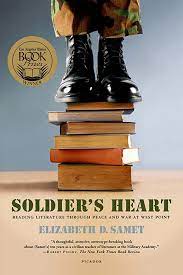"Soldier's Heart."
2 decades ago, I met a unique person at West Point.
An Ivy League English Literature Professor teaching Plebes (Freshmen), Elizabeth Samet was writing a book about how cadets were facing the wars that would define their generation. 1/11
2 decades ago, I met a unique person at West Point.
An Ivy League English Literature Professor teaching Plebes (Freshmen), Elizabeth Samet was writing a book about how cadets were facing the wars that would define their generation. 1/11

In that book, she describes what it was like coming to a place like @WestPoint_USMA, and learning the military culture.
She would teach cadets about war, masterfully using literature to describe what they would soon face.
They loved her for that. 2/
northcountrypublicradio.org/news/npr/15890…
She would teach cadets about war, masterfully using literature to describe what they would soon face.
They loved her for that. 2/
northcountrypublicradio.org/news/npr/15890…
But she would also learn so much from her students...and graduates, as they wrote to her after experiencing what she had only read about in the classics.
The book, "Soldier's Heart," is one of my favorites, and it holds a special place on my bookshelf as she signed it for me. 3/
The book, "Soldier's Heart," is one of my favorites, and it holds a special place on my bookshelf as she signed it for me. 3/

But tonight I'll write of Ukrainian (& Russian) soldiers.
Their physical, emotional & mental fatigue after 16 months of war.
While many talk of Leos, Bradleys, F16s & ATACMs - the weapons of war - we overlook the men & women who are doing the fighting. 4/
Their physical, emotional & mental fatigue after 16 months of war.
While many talk of Leos, Bradleys, F16s & ATACMs - the weapons of war - we overlook the men & women who are doing the fighting. 4/

Professor Samet titled her book "Soldier's Heart" because that was one term used by battlefield physicians since the Civil War.
It was used to describe soldiers w/ dizziness, shortness of breath, morose behavior, rapid heart rate & a general malaise difficult to identify. 5/
It was used to describe soldiers w/ dizziness, shortness of breath, morose behavior, rapid heart rate & a general malaise difficult to identify. 5/
Today we describe those symptoms as being associated with Post Traumatic Stress (PTS) and PTS-Disorder (PTSD).
Symptoms include distorted nightmares & flashbacks, inability to remember events & a general numbing of emotions. 6/
Symptoms include distorted nightmares & flashbacks, inability to remember events & a general numbing of emotions. 6/

In combat, senses are bombarded by unpleasant sights, smells of death, cacophony of sounds, extreme cold & heat.
The loss of comrades & sights of wounded friends.
Fatigue is exponentially compounded by lack of sleep, heightened tensions, constant fear, poor diet. 7/
The loss of comrades & sights of wounded friends.
Fatigue is exponentially compounded by lack of sleep, heightened tensions, constant fear, poor diet. 7/
Studies have shown all these factors are worse in the intensity of the offense more than the static nature of the defense.
It is, to use the trite saying, a "condition of the battlefield."
On the modern battlefield like we're seeing now, we don't have a lot of research. 8/
It is, to use the trite saying, a "condition of the battlefield."
On the modern battlefield like we're seeing now, we don't have a lot of research. 8/
When I served at our Army's National Training Center in California, we did several studies on the effect of sleep deprivation on leadership decision-making.
The results were sobering..
Let's just say decisions after even 48-72 hours w/out adequate sleep were "affected." 9/
The results were sobering..
Let's just say decisions after even 48-72 hours w/out adequate sleep were "affected." 9/
It's relatively easy to watch this battlefield from a distance, and offer advice on what soldiers & their leaders should be doing.
I offer this 🧵to as a reminder to those who have never faced battle that it is much tougher on the battlefield than it is playing a video game. 10/
I offer this 🧵to as a reminder to those who have never faced battle that it is much tougher on the battlefield than it is playing a video game. 10/
One more thing...
Studies in combat show that units are more resilient & have the ability to better counter PTS, battle fatigue, or soldier's heart if they believe in what they're doing & have faith in their leaders.
In this fight, only one side has that. 11/11
Studies in combat show that units are more resilient & have the ability to better counter PTS, battle fatigue, or soldier's heart if they believe in what they're doing & have faith in their leaders.
In this fight, only one side has that. 11/11
• • •
Missing some Tweet in this thread? You can try to
force a refresh

 Read on Twitter
Read on Twitter




